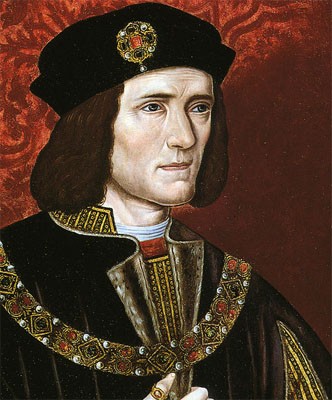King Richard III Remains Suggests Maternal Infidelity
| Ana Verayo | | Dec 02, 2014 11:18 PM EST |
(Photo : Wikipedia) King Richard III of England was known as the hunchback king.
Under a nondescript British parking lot lie the remains of King Richard III. How this infamous king got there and how scientists conclusively determined the bones were Richard's are feats worthy of praise.
King Richard III was killed in battle in 1485 after a short reign and was later immortalized by Shakespeare. Richard was buried under a church that was destroyed and demolished long ago.
Like Us on Facebook
Researchers found the church's foundations, which is now part of a parking lot in Leicester.
After exhuming the skeleton, researchers determined the identity of the remains by examining its age, wounds from weapons and signs of scoliosis. Richard III was famously described as the "hunchback king" in Shakespeare's play.
Apart from this evidence, DNA was also uncovered from the skeleton. The team then tracked down the living descendants of the king to further complete an in depth analysis of their genetic make-up. Researchers scanned the lines of inheritance to confirm if the centuries-old skeleton was part of the royal family tree.
According to geneticist Turi King from the University of Leicester, all the evidence, including the scoliosis and DNA, point to the exact date and location in history when Richard was killed. The chance of this happening is one in 100,000 and the evidence is overwhelming the remains are those of Richard III.
Another surprising result from the genetic research was strong evidence pointing to infidelity on Richard's maternal side. This finding suggests Richard had an illegitimate claim to the throne.
Detailing this infidelity in the royal lineage, researchers found out that all the maternal side matches the DNA of the living descendants. Researchers say this wasn't surprising because there is this thing called female infidelity or cuckolding.
Richard III was the last reigning king from the House of York. He was killed in the Battle of Bosworth in 1485 by Henry Tudor. Richard's death marked the end of the Plantagenet dynasty and paved the way for the rise of the Tudor dynasty.
TagsKing Richard III DNA Confirmed Under Parking Lot; Infidelity Doubts Royal Lineage, king richard III, richard III shakespeare, DNA skeleton parking lot richard III, leicester, King Richard III Remains Under Parking Lot DNA Confirmed; Infidelity Doubts Royal Lineage
©2015 Chinatopix All rights reserved. Do not reproduce without permission
EDITOR'S PICKS
-

Did the Trump administration just announce plans for a trade war with ‘hostile’ China and Russia?
-

US Senate passes Taiwan travel bill slammed by China
-

As Yan Sihong’s family grieves, here are other Chinese students who went missing abroad. Some have never been found
-

Beijing blasts Western critics who ‘smear China’ with the term sharp power
-

China Envoy Seeks to Defuse Tensions With U.S. as a Trade War Brews
-

Singapore's Deputy PM Provides Bitcoin Vote of Confidence Amid China's Blanket Bans
-

China warns investors over risks in overseas virtual currency trading
-

Chinese government most trustworthy: survey
-

Kashima Antlers On Course For Back-To-Back Titles
MOST POPULAR
LATEST NEWS
Zhou Yongkang: China's Former Security Chief Sentenced to Life in Prison

China's former Chief of the Ministry of Public Security, Zhou Yongkang, has been given a life sentence after he was found guilty of abusing his office, bribery and deliberately ... Full Article
TRENDING STORY

China Pork Prices Expected to Stabilize As The Supplies Recover

Elephone P9000 Smartphone is now on Sale on Amazon India

There's a Big Chance Cliffhangers Won't Still Be Resolved When Grey's Anatomy Season 13 Returns

Supreme Court Ruled on Samsung vs Apple Dispute for Patent Infringement

Microsoft Surface Pro 5 Rumors and Release Date: What is the Latest?










